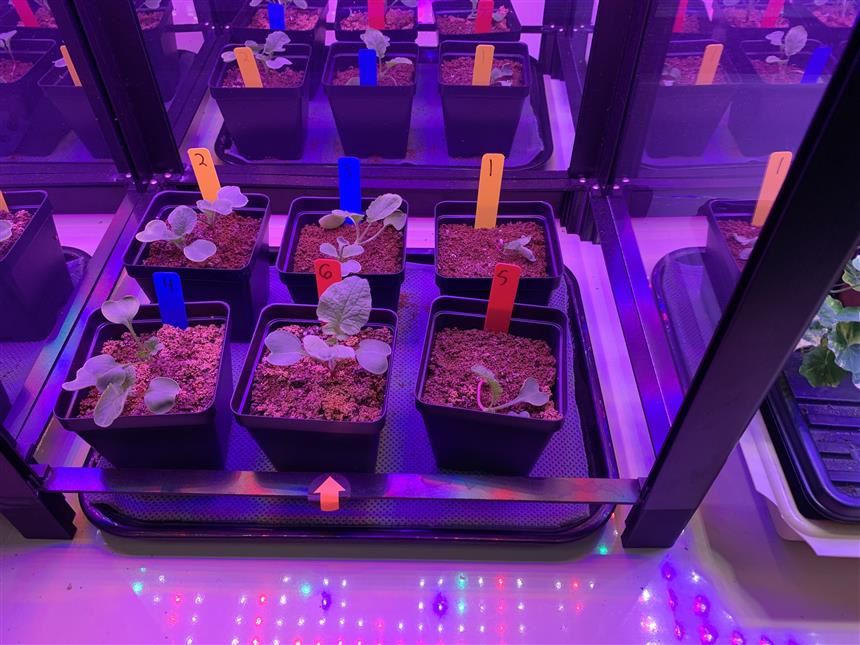Mr. Sanders’ Students Reach For the Stars in NASA’s Pepper and Radish Experiment
![]()
Gabrielle Lim '23
1 April 2022
Mr. Randall Sanders and his STEM Explorations classes collected data on the growth of Mexican chili peppers and radishes in a closed environment experiment simulating the conditions of the International Space Station. Students are sending their data to NASA to help further their research on how they can grow food in such alien environments.
After speaking to a group of NASA scientists on a Reddit Ask Me Anything, Mr. Sanders presented an interesting experiment to the students of last year's STEM Explorations class. NASA Scientist Jacob Torres and Mr. Sanders’ class became the first to conduct the experiment. Now, Mr. Torres collaborates with thousands of schools across the world to collect data and teach students about hydroponics.
 As NASA explores more and more of space, they must find creative ways to provide food for the astronauts that travel beyond Earth’s habitat. Students are required to test variables that will affect the growth of their plants while in a closed environment. The experiment consists of two different plants: radishes and peppers. Mr. Sanders and his students have replicated the Space Station’s veggie system to grow the radishes, which consists of an open chamber and different vegetables being grown on-site. For the peppers, students are not able to fully replicate the Advanced Plant Habitat that is used on the Space Station. Students still continue to grow peppers and send their data to help researchers compare results due to the difference in environments.
As NASA explores more and more of space, they must find creative ways to provide food for the astronauts that travel beyond Earth’s habitat. Students are required to test variables that will affect the growth of their plants while in a closed environment. The experiment consists of two different plants: radishes and peppers. Mr. Sanders and his students have replicated the Space Station’s veggie system to grow the radishes, which consists of an open chamber and different vegetables being grown on-site. For the peppers, students are not able to fully replicate the Advanced Plant Habitat that is used on the Space Station. Students still continue to grow peppers and send their data to help researchers compare results due to the difference in environments.
In this ongoing experiment, students have experienced a variety of results. Students have witnessed plants with nitrogen deficiencies and unique shape deformities. For the pepper plants, students have attempted to create a hot pepper and results have ranged from levels of mild to spicy.
 Checkups have become routine for the students. “Every morning, everybody gets up and the first thing they do is water their plants [and] check their plants. That’s our basic daily routine in class,” said Betule Zaher ’25. Students observe and log their daily findings following their checkups. Students look for any deformities, dehydration, signs of deficiencies, and any other noticeable indicators that could give them insight towards growing their plants.
Checkups have become routine for the students. “Every morning, everybody gets up and the first thing they do is water their plants [and] check their plants. That’s our basic daily routine in class,” said Betule Zaher ’25. Students observe and log their daily findings following their checkups. Students look for any deformities, dehydration, signs of deficiencies, and any other noticeable indicators that could give them insight towards growing their plants.
By conducting these experiments, students are experiencing and learning new scientific skills that will benefit them if they enter science professions. Students are developing skills in observing, analyzing, drawing conclusions, and gaining knowledge on the topic of hydroponics. “It’s getting down to the nuts and bolts of science. It’s showing them how to collect data, how to be detail-oriented, and how to really pay attention to the little things,” said Mr. Sanders.
Students are also excited to be contributing to research conducted by NASA. “To be able to contribute to an organization as big as NASA, that’s always something I look forward to. It’s inspiring because we get to stand out in a way that’s different from other schools,” said Kacey DiPasquale ‘25.

